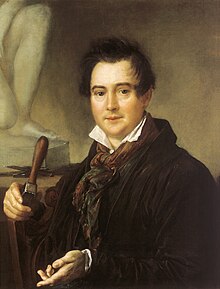Ivan Vitali: Difference between revisions
Content deleted Content added
→top: short description |
→Bibliography: recategorize to Category:19th-century Russian male artists |
||
| Line 26: | Line 26: | ||
{{DEFAULTSORT:Vitali, Ivan}} |
{{DEFAULTSORT:Vitali, Ivan}} |
||
[[Category:19th-century Russian sculptors]] |
[[Category:19th-century Russian sculptors]] |
||
[[Category:19th-century male artists]] |
[[Category:19th-century Russian male artists]] |
||
[[Category:Russian male sculptors]] |
[[Category:Russian male sculptors]] |
||
[[Category:Neoclassical sculptors]] |
[[Category:Neoclassical sculptors]] |
||
Revision as of 01:01, 13 May 2022

Ivan Petrovich Vitali (Russian: Иван Петрович Витали; 1794–1855) was a Russian sculptor of Italian descent. Born in Saint Petersburg, he was apprenticed to his father, Pietro Vitali, from an early age. After attending the Imperial Academy of Arts he moved to Moscow in 1818. His major works include a six-horse chariot for Bove's Triumphal Arch, a fountain in front of the Bolshoi Theatre (1825),[1] the bas-reliefs above the doors of St. Isaac's Cathedral, and an outdoor bronze statue of Emperor Paul in Gatchina.
Works
- Large headboard group crowning the Bauman Higher Technical School in Moscow, formerly the Trade Educationa Establishment technical training center. 1820s.[2]
- No. 14 Solyanka street, designed by Giacomo Gilardi, bas reliefs, 1823-26[3]
- No. 14 Leninsky Prospekt, gateway pillars (1835), and a fountain in the forecourt that "originally stood in Dzerzhinsky Square."[4]
-
St. Isaac's Cathedral
-
Bolshoi Fountain
References
Wikimedia Commons has media related to Ivan Vitali.
- ^ Mears 1968, p. 131.
- ^ Mears 1968, p. 127.
- ^ Mears 1968, p. 149.
- ^ Mears 1968, p. 155.
Bibliography
- Mears, Bernard (1968). Moscow: Architecture and Monuments. Translated by Bean. Moscow: Progress Publishers.
- Якирина Т. В., Одноралов Н. В., Витали, Л.-М., 1960.


